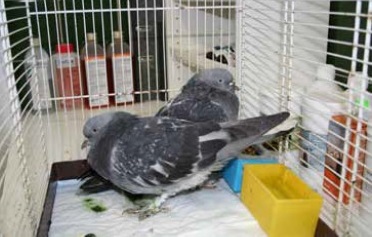

Deadly E.coli infections in Germany
Sick pigeons following exhibitions
For several years now, we have been consulted by German pigeon fanciers in particular, who have had big problems during and after exhibitions and not only with their exhibited pigeons.
The problem especially occurs with various kinds of show pigeons, some species seem more sensitive than others. The pigeons get sick during the exhibition, becoming lifeless and apathetic. They usually have vomiting tendencies and die quickly. Once back from the show, the infection spreads so quickly that other pigeons start dying at home.
It is remarkable that in many different places the same problems occur at the same ‘time’, namely during the exhibition period. You should always suspect Paramyxo (PMV) in such circumstances. Often accompanied by rapid death without clear symptoms. On further investigation, we always found E.coli bacteria present, but they can be found everywhere and at all times, so that has to be interpreted very carefully.
After ‘follow up’ and careful consideration, we were convinced that this was always about a certain E.coli infection . Known registered drugs did not work sufficiently. Baytril was often used, but usually without result. After a number of tests, we found a little used antibiotic X that worked well, so we were able to help many fanciers (their pigeons actually).
Atypical E.coli
Besides these annually recurring exhibition problems, especially with show pigeons, we also saw a number of atypical E.coli cases in the summer, again in Germany.
That started at a pigeon fancier H. near Euskirchen. He was training his youngsters in week 26 and noticed that they had vomited in the baskets, they didn’t finish quickly and didn’t feel like coming in! The pigeons ate less and less, drank a little and then sat down on their ‘shelves’, had thin green droppings and died after a few days. The image changed in that sense that the pigeons, sometimes still in good condition (round and pink), died abruptly. Again, Baytril was given by colleagues, but without result. By now, 40 youngsters had already died!
Meanwhile Mr. H. had gone to the German pigeon clinic with a few sick pigeons, of which 2 were already dead on arrival. Two living pigeons were left in the clinic for further research. They were forwarded to the University of Hannover.
Antibiotic X
The treating veterinarian in that German pigeon clinic advised him to continue with the Baytril and add some electrolytes. However, there was no improvement at all and it even got worse, more pigeons died! After a week, H. stopped the treatment, then he gave another so-called ‘miracle drug’ from the Netherlands, a prebiotic (called …?…..), a kind of mix against E.coli! According to the provider of the remedy you could almost “bring dead pigeons back to life”, but the remedy did not help at all.
In mid-July he also raced yearlings on a 350 km training flight (long-distance race). They had also vomited in the baskets, which is where the misery also seemed to begin! Meanwhile Mr. H. had heard through the grapevine about similar problems with a few other fanciers. These had received from me the same antibiotic X as described above for the ‘show pigeons’. Fortunately, there was a quick improvement and healing of this atypical E.coli problem.
The yearlings, 56 of them, were then raced to Brive, 745 km, resulting in 50% prizes and 2 lost. The old pigeons that were preventively treated with the drug X over 5 days, could still compete on to Perpignan. This final flight was also successful. The youngsters had recovered amazingly well. All this information was communicated to me by letter from Mr H.
Practical experience
The moral of the story is that practical experience is incredibly important. It is also very important to follow up all kinds of illnesses so that you have a good idea of how quickly the pigeons react to a treatment and how they recover. In the case of Mr H. mentioned above, the colleague in the pigeon clinic was thinking of a new type of virus or a bacterium. On 4 September, H. was informed by the University of Hannover that the 2 dead pigeons that were sent to the university on 17 July were diagnosed with a hitherto unknown virus, as well as in similar cases of colleagues. But this unknown virus played no role at all, otherwise we would never have been able to cure the pigeons so quickly.
If we hadn’t intervened mid-July, H. would probably have been ‘finished’ as a pigeon fancier. It took the university almost 2 months to arrive at a very unsatisfactory diagnosis (without therapy).
There is often a huge gap between science and practice.
BELGICA DE WEERD B.V. I Postbus 4607 I 4803 EP Breda I Nederland
T +31 76 560 02 22 I F +31 76 565 35 70 I info@belgicadeweerd.com I www.belgicadeweerd.com

